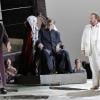
For anyone who thinks a conductor’s work consists of simply waving a baton, there’s a most instructive film streaming for free on San Francisco Opera’s website that sets the record straight.
Elena Park’s Eun Sun Kim: A Journey Into Lohengrin is a fascinating, insightful, illuminating documentary about the company’s music director, as well as its soloists, chorus, orchestra musicians, crew, and staff — and how all of their work melds into the most complex and majestic of performing arts.
The film, perfect for newcomers, veteran fans, and everybody in between, focuses on SF Opera’s 2023 production of Richard Wagner’s Lohengrin and is not interrupted by commercials. There’s not even a request for contributions at the end.
General Director Matthew Shilvock, who hired Kim and is an executive producer of the documentary, can be proud.
The hourlong film — which will also be telecast on KQED 9 on Nov. 1 at 8 p.m. — feels like a full-length feature. It begins with Kim running around the labyrinthine backstage of the War Memorial Opera House, score in hand, talking about details of the music with singers, making contact with everybody.
Fast-forward to the end of the documentary, and after all the work and triumph, Kim greets fans at the stage door and walks into the silence of the nighttime city.
Between those parallel scenes is a dizzying medley of hectic preparations, great effort, collaboration, and jubilation.

At the time of her appointment in December 2019, Kim, already famous in European opera houses and concert halls, made headlines as SF Opera’s first woman and first Asian music director. She has quickly progressed beyond simply being a “first,” becoming one of the busiest and most appreciated conductors in the company’s history.
She made her reputation here beginning with a sensational debut of the same kind that her two immediate predecessors delivered. Her triumph in SF Opera’s 2019 production of Antonín Dvořák’s Rusalka, which earned her the appointment, mirrored the history of Donald Runnicles making a big splash leading Wagner’s Ring cycle in 1990 and Nicola Luisotti impressing with Giuseppe Verdi’s La forza del destino in 2005.
Kim’s Rusalka received unanimous acclaim from performers, critics, and audiences. After the debut, a veteran musician in the SF Opera Orchestra said: “She is perhaps the best conductor we’ve had in a long time. So musical, and she ‘looks’ like the phrasing. No ego, all music. And she speaks Czech!”
Besides Korean, English, and German, Kim is fluent in several other languages, and she always reads and memorizes a libretto in its native language. Whenever she conducts, she always mouths the words.
But following the excitement of Kim’s appointment was the pandemic, which shut down the company and kept the conductor in her Vienna residence. What feels like a long tenure of many successes is in fact only three years of concentrated work, with such triumphs as 2021’s Fidelio and the 2022 world premiere of John Adams’s Antony and Cleopatra.

The 2023 production of Lohengrin that’s focused on in the film was notable because it featured experienced Wagnerians, such as tenor Simon O’Neill as Lohengrin and bass Kristinn Sigmundsson as King Heinrich, collaborating with artists who were debuting in their roles, including soprano Julie Adams as Elsa, mezzo-soprano Judit Kutasi as Ortrud, baritone Brian Mulligan as Telramund, and — yes — Kim conducting the opera for the first time.
The documentary follows everyone’s preparations, from coaching sessions with the singers to the staging of large choral scenes to rehearsals that deal with the balance of the orchestra in the pit and around the War Memorial.
Interviews with the cast reveal the challenges of performing these daunting roles. Orchestra musicians describe the nonverbal, almost telepathic communication methods that develop in rehearsal. Music and production staff detail the military-level precision required to wrangle hundreds of artists, crew, and backstage staff.
Subtitles, available in English and Korean, always indicate who is speaking.
Interspersed in all the action, Kim shares anecdotes from her early days in opera and the experiences that readied her for a skyrocketing career. Born in Seoul, she started playing the piano at age 4 and surprised teachers with her perfect pitch.
She studied composition and conducting at Korea’s Yonsei University and then trained in Stuttgart and Madrid. Her early career in Europe was supported by an impressive array of mentors, including Daniel Barenboim, then music director of the Berlin State Opera.

Last week, after the release of the documentary, SF Classical Voice contacted an administrator at the Berlin State Opera, who said: “What a lovely film! Eun Sun has such a wonderful personality; most of the time she is comfortable, friendly, cheerful. And she brings energy to her work, intensity. She is inspiring, ‘vibrating,’ and has a good sense of humor.”
In an SF Opera press release, Shilvock commented, “It is a joy to take this journey with Eun Sun Kim and to experience her unbridled devotion to producing artistry of the very highest level. She is carrying forth the tradition of excellence that has defined our company for over 100 years, and this film gives a unique glimpse into her amazing creative vision.”
Kim’s 2024–2025 season with SF Opera includes Wagner’s Tristan and Isolde and Mozart’s Idomeneo, both firsts for her. In November, she makes her Royal Opera House Covent Garden debut with Giacomo Puccini’s Tosca, and in March 2025, she returns to the Berlin State Opera for Verdi’s Simon Boccanegra, with orchestra engagements in Madrid, Los Angeles, Boston, and Seville on her schedule as well.
Also on tap: Kim conducts the SF Opera Orchestra in Beethoven’s Ninth Symphony on Oct. 26 at the War Memorial. Another performance featuring musicians of the orchestra, this time under the direction of violinist Dawn Harms, precedes the Beethoven, Oct. 20 at the San Francisco Conservatory of Music.
Filmmaker Elena Park, in addition to her local connections as the former public relations manager at SF Opera and creator of the company’s In Song video portrait series, was supervising producer for some 140 of the Metropolitan Opera’s Live in HD broadcasts and remains an executive producer of the Met’s radio broadcasts. She sat down with SFCV for a brief interview.

How did you capture Kim’s preperformance whirlwind as your opening scene?
ESK moves fast. When cinematographer Mitchell Kell and I did our maiden voyage, following her for a performance of [Verdi’s Il] trovatore, we couldn’t believe how much ground she covered in a short amount of time, only minutes before curtain.
I only had to follow along, but Mitch had to keep up the pace while keeping the camera steady and being sure to get good shots. For the next time we trailed her backstage, prior to the downbeat of Lohengrin, he had ideal gear and footwear so was able to beautifully capture the dressing-room visits we see at the beginning of the film.
How difficult was it to get Kim’s cooperation in the middle of her frantic work?
ESK doesn’t mind being filmed as long as you don’t distract her one iota from the music. She is too occupied with the work at hand to care or notice. But later, she was amused to see the footage we shot — “Oh, you were there?”
How did you manage getting such complete access for yourself, the crew, and so many cameras in the already jam-packed backstage area?
I’ve had the luxury of being backstage in opera houses and theaters for many years in San Francisco and New York City — privy to a lot of the exquisite and detailed work that goes into something as ambitious and complex as a new staging of a Wagner opera.
Creating a film with ESK at the center of the complexity and being able to follow her through the various stages of rehearsals and conversations — negotiating and guiding the myriad details that come into play as the artists hurtle toward opening night — was a joy and also a fascinating exercise for me and my filmmaking colleagues.
How do you choose among the many storylines on offer? How do you pick only a handful of quotes from the many things the personalities — and they are personalities — shared in interviews? What rises to the top and reinforces the spine of the nuanced story we want to tell?
With all the Wagnerian gigantism around, how did you manage to feature Lohengrin’s most subtle passage, the procession to the cathedral toward the end of Act 2?
I wouldn’t have anticipated devoting a few minutes to a woodwind serenade in a film about a Wagner opera. But many of the musicians I interviewed singled out that moment in the piece where, as [oboist] Gabe Young says, the strings get a much-needed and well-deserved break.
It’s a little love letter to the woodwind section and shows Wagner’s range — from “Wagnerian” to delicate and intimate.

How was it possible to capture close-ups of musicians located all around the opera house, from under the stage to enclosures where they were placed to produce a truly “stereophonic” sound?
I was delighted that SF Opera’s media team was game to put cameras in every nook and cranny where musicians were situated [to allow] us to try to convey the technical and musical challenges inherent in the score. It was a challenging but fun puzzle, particularly for my brilliant editor, Steve Mallorca.
What was your ambition with the documentary?
I hope for a deeper understanding about the striving, the beauty, and the humanity of the artists and production people who work so hard each and every day, most of them offscreen, to try to produce the conditions in which, as [Chorus Director] John Keene says toward the end of the film, magic might show up.
I think that’s what we are all seeking from time to time, whether that’s in music and the arts or sports or other pursuits where people seek perfection and hope to create something extraordinary.
And as a Korean American filmmaker who cut her teeth at San Francisco Opera years ago, it’s a particular gift to be able to capture the work of this young, singular, international maestro on the rise and, through Eun Sun Kim’s story, that of a larger company.




